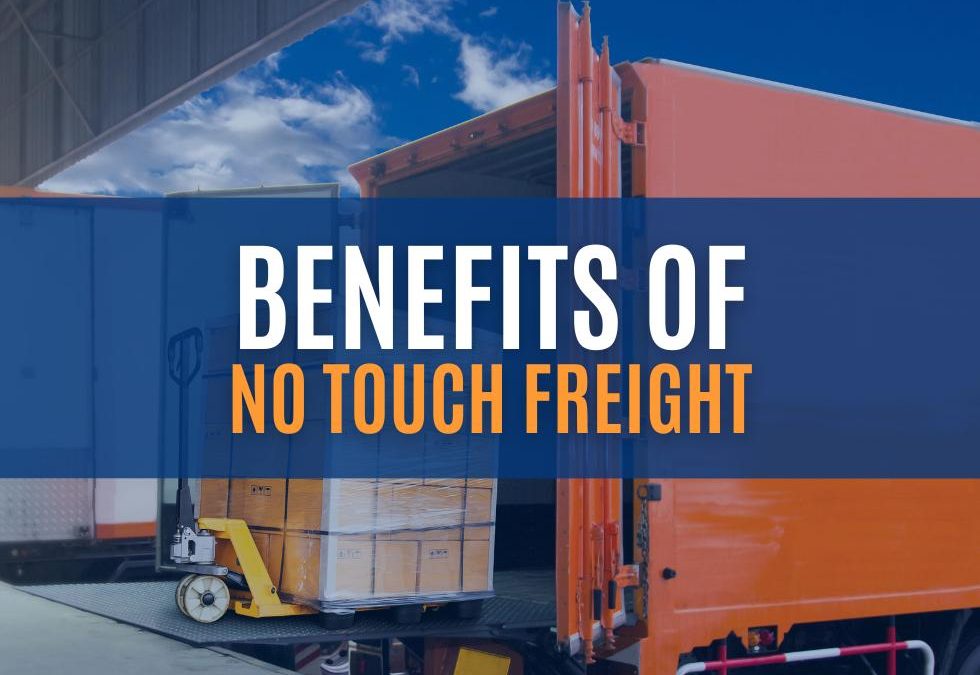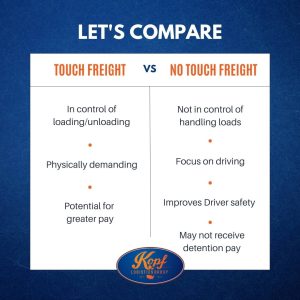One of the fastest growing trends in logistics is no touch freight. Whether you’re a Driver looking for better job conditions, a Carrier aiming to strengthen your network, a Freight Broker searching for ways to provide added value, or a Shipper wanting to speed up operations, no touch freight offers clear benefits that make it a competitive advantage in today’s logistics industry.
Let’s take a closer look at what no touch freight is, its benefits for Carriers, Brokers and Agents, Drivers, and Shippers, and some challenges and considerations to keep in mind.
What is No Touch Freight?
No touch freight is a shipping process where truck drivers are not responsible for loading or unloading cargo. Instead, a Shipper’s warehouse staff, facility employees, or third party contractors are responsible with handling these tasks.
This type of freight has grown in popularity because it reduces Driver strain, minimizes workplace injuries, lowers liability, and improves overall efficiency.
However, even though it is trending, no touch isn’t necessarily “better” for all Drivers. This is because it depends on what is of value to each individual. Some Drivers prefer to handle the freight and know the condition of their load. They would rather not wait on a Shipper’s crew to do the work. Other Drivers don’t mind waiting and appreciate handing off the handling responsibilities.
Keep in mind sometimes no touch freight does not mean 100% touch-free for Drivers. Sometimes a Driver must secure the load or make minor adjustments such as reshuffling boxes.
Touch Freight vs. No Touch Freight
Touch freight is when a Driver is physically involved in the loading and unloading of freight from their truck. Drivers may operate equipment like pallet jacks, liftgates, load bars or straps, and dollies. Bottom line: this type of freight involves additional physical labor for Drivers.
Sometimes touch freight also requires Drivers to have proper training in safe handling techniques (such as with liquid bulk and refrigerated freight). Due to this added physical demand, touch freight has greater liability and also the potential for higher pay.
In contrast, a Driver transporting no touch freight does not load or unload their truck. They are responsible for transporting the cargo from point A to point B. This results in less physical labor for Drivers and often greater turnaround time. It can also mean less pay as compared to Drivers moving touch freight.
How Does No Touch Freight Work?
No touch freight can be any kind of freight from electronics to grocery items to construction equipment. Sometimes it can be hazardous or high-value items that require specialized handling. If the Driver doesn’t load or unload the freight, it is no touch.
The Basic Process
- First, a Driver arrives at the loading dock and waits while the Receiver’s crew unloads the freight. Usually a Driver waits in the cab during this time.
- Next, one of three things happens: Either the Driver leaves with an empty trailer, waits for the Shipper or Receiver’s crew to reload the trailer, or unhooks their trailer and hooks to another trailer that is already loaded (Drop and Hook).
- Last, the Driver drives to the next location.
How Drop and Hook Works
Drop and Hook is a popular kind of no-touch freight. This is when a Driver drops off an empty trailer, unhooks, and immediately picks up a pre-loaded one. It minimizes loading time and keeps freight moving efficiently. This solution is great for high-volume lanes where speed and efficiency are critical.
Benefits of No Touch Freight
In general, no touch freight is beneficial for everyone involved in the transportation process: Shippers, Freight Agents, Drivers, and Carriers.
For Shippers and Freight Agents
No touch freight speeds up operations with faster turnaround, reduces labor costs, and simplifies negotiations. It can also boost efficiency and make scheduling more predictable. This is especially true with Drop and Hook services.
For Drivers
For many Drivers, the manual work of shifting freight can be back-breaking. No touch freight is a great option for a Driver who wants to focus on driving. While the Driver is at the loading dock, he or she can rest, talk with family, and take care of themselves. Sometimes a Driver waits half an hour or even hours at a time. In addition, Drivers have less overall liability and reduced likelihood of injuries since they aren’t handling the freight on a loading bay.
For Carriers
With no touch, there is improved Driver retention, safety, and job satisfaction. Carriers can let their Drivers focus on driving rather than heavy labor. This often makes it easier for Carriers to recruit Drivers.
Types of No Touch Freight Jobs
There are a variety of no touch freight jobs for Drivers including dry van, tanker, reefer, and drop and hook.
- Dry van: standard, non-temperature-controlled trailer
- Tanker: liquid or gaseous cargo
- Reefer: refrigerated loads
- Drop and Hook: drop a pre-loaded trailer and immediately hook onto a different pre-loaded trailer
Some job listings say “mostly no touch” which means Drivers still might do some handling. Large Shippers and major Carriers are often looking for no touch Drivers.
Challenges and Considerations
While no touch freight is attractive for reducing Driver labor, it comes with its own set of challenges and trade-offs. Any Driver, Shipper, or Carrier wanting to include no touch freight should keep these challenges and considerations in mind.
1. Delays at Shipper or Receiver facilities
Long wait times at loading docks can become a major issue. Poor scheduling by the Shipper or Receiver, long lines during peak hours, and limited dock workers or equipment can result in lost drive time, Hours of Service violations, and lower daily mileage. Some companies pay detention time after a certain waiting period, such as 1-2 hours.
2. Availability varies by region
No touch freight is not available everywhere. It is less common in rural areas, some food and beverage distributors, and specialized freight such as furniture and heavy equipment. It is more common in major logistics hubs like Dallas, Los Angeles, Atlanta, and Chicago. No touch is also more common with retail or consumer goods.
3. Rate and pay differences
Higher pay is possible for reefer no touch freight, drop and hook routes with high mileage, and no touch dedicated accounts with time-sensitive delivery windows. But no touch doesn’t always mean higher pay. Some Carriers consider no touch freight “easier” which can mean lower pay per mile. And, the time a Driver is waiting for a load to be loaded or unloaded can be excessive. If those wait times come without detention pay, this can cut into income. So it is important for Drivers to ask about the rate per mile, detention policies, and average wait times with no touch freight.
4. Lack of control over loads
Since a Driver doesn’t load their trailer, they can’t always inspect or secure it themselves. Improperly loaded cargo has a risk of damage or shifting. When possible, Drivers should double-check their load to make certain it is secure before driving.
5. Job competition
No touch is becoming more desirable for Truck Drivers. Carriers may prefer Drivers with clean Motor Vehicle Records, experience with time-sensitive windows, reliable attendance, and on-time history.
Explore No Touch Options
In trucking today, no touch freight can benefit Freight Agents with simplified negotiations, Carriers with increased Driver retention, Shippers with faster turnaround, and Drivers with greater job satisfaction. It reduces labor costs, improves safety, and boosts efficiency. While there are numerous benefits to no touch freight, it is also important to keep in mind it may not be ideal for all Drivers. If you are like many Drivers today, the benefits outweigh the potential challenges.
If you are a Driver looking to transport no touch freight, please check out the benefits of driving for Kopf. As a 3PL with our own fleet of trucks, we also offer Drop and Hook services for Shippers and partner with Contract Carriers.
Questions People Also Ask
What does no touch freight mean?
It means the Driver does not load or unload freight. Instead, the Shipper or Receiver’s staff or third party contractors handle it.
What are the benefits of no touch freight?
Less physical labor, improved safety, faster delivery, reduced liability, and better Driver retention.
What is the difference between touch freight and no touch freight?
Touch freight requires drivers to load/unload freight, while no touch freight keeps Drivers focused on driving only.
Is no touch freight better for Drivers?
This depends on a Driver’s priorities. Often yes, because it reduces physical strain, lowers injury risk, and allows Drivers to maximize driving hours. However sometimes no, because it can result in less pay with extensive waiting periods and less control over loads.
What are no touch freight jobs?
Driver positions (dry van, tanker, reefer, drop and hook) where freight handling is done by warehouse staff.


